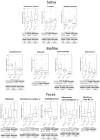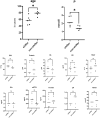Impact of sucroferric oxyhydroxide on the oral and intestinal microbiome in hemodialysis patients
- PMID: 35689007
- PMCID: PMC9187715
- DOI: 10.1038/s41598-022-13552-z
Impact of sucroferric oxyhydroxide on the oral and intestinal microbiome in hemodialysis patients
Abstract
Hyperphosphatemia is a consequence of chronic kidney disease associated with mineral/bone impairment, increased cardiovascular events and mortality. Therapeutically, most dialysis patients have to take phosphate binders. Here, we investigated effects of the Fe(3+)-based phosphate binder sucroferric oxyhydroxide (SFOH) on the oral and gastrointestinal microbiome of 11 hemodialysis patients. Saliva, dental plaque and stool were collected at baseline, one and four weeks of SFOH intake and subjected to 16S rRNA gene (V3-V4 region) directed Illumina MiSeq-based analysis. Total Fe, Fe(2+) and Fe(3+) were determined in stool and saliva. Overall, the microbiome did not change significantly. However, some patient-, sample- and taxon-specific differences were noted, which allowed patients to be divided into those with a shift in their microbiome (6/11) and those without a shift (5/11). Total Fe and Fe(2+) were highest after one week of SFOH, particularly in patients who exhibited a shift in microbiome composition. Eight bacterial taxa showed significant unidirectional changes during treatment. In-depth microbiome analysis revealed that taxa that significantly benefited from iron plethora had no iron-binding siderophores or alternatives, which was in contrast to taxa that significantly declined under iron plethora. Patients with microbiome-shift were significantly younger and had higher serum phosphate concentrations. In conclusion, this study sheds light on the impact of iron on the microbiome of hemodialysis patients.
© 2022. The Author(s).
Conflict of interest statement
The authors declare no Competing Non-Financial Interests but the following Competing Financial Interests. This is an investigator initiated clinical study but financially supported by Vifor Fresenius Medical Care Renal Pharma Ltd. Author J.F. has received lecture and consulting fees from Vifor Fresenius Medical Care Renal Pharma Ltd. All other authors (M.M.H.A., C.K., S.S-Y.M., T.K., and G.C.) have otherwise nothing to declare.
Figures







Similar articles
-
Gut microbiome in hemodialysis patients treated with calcium acetate or treated with sucroferric oxyhydroxide: a pilot study.Int Urol Nephrol. 2022 Aug;54(8):2015-2023. doi: 10.1007/s11255-021-03091-3. Epub 2021 Dec 19. Int Urol Nephrol. 2022. PMID: 34923600 Free PMC article. Clinical Trial.
-
The real-world effectiveness of sucroferric oxyhydroxide in European hemodialysis patients: a 1-year retrospective database analysis.BMC Nephrol. 2020 Dec 7;21(1):530. doi: 10.1186/s12882-020-02188-8. BMC Nephrol. 2020. PMID: 33287733 Free PMC article.
-
Long-term efficacy and safety of sucroferric oxyhydroxide in African American dialysis patients.Hemodial Int. 2018 Oct;22(4):480-491. doi: 10.1111/hdi.12663. Epub 2018 Apr 15. Hemodial Int. 2018. PMID: 29656600 Clinical Trial.
-
Sucroferric oxyhydroxide for hyperphosphatemia: a review of real-world evidence.J Nephrol. 2022 Apr;35(3):875-888. doi: 10.1007/s40620-021-01241-5. Epub 2022 Feb 9. J Nephrol. 2022. PMID: 35138627 Free PMC article. Review.
-
Sucroferric oxyhydroxide for the treatment of hyperphosphatemia.Expert Opin Pharmacother. 2018 Jul;19(10):1137-1148. doi: 10.1080/14656566.2018.1491548. Epub 2018 Jul 9. Expert Opin Pharmacother. 2018. PMID: 29985725 Review.
Cited by
-
Characteristics of tongue coating microbiota in diabetic and non-diabetic kidney patients receiving hemodialysis.BMC Oral Health. 2025 Jan 20;25(1):104. doi: 10.1186/s12903-025-05455-y. BMC Oral Health. 2025. PMID: 39833942 Free PMC article.
-
Gut Microbiota in Chronic Kidney Disease: From Composition to Modulation towards Better Outcomes-A Systematic Review.J Clin Med. 2023 Mar 1;12(5):1948. doi: 10.3390/jcm12051948. J Clin Med. 2023. PMID: 36902734 Free PMC article. Review.
-
Gut Microbiota Interventions to Retain Residual Kidney Function.Toxins (Basel). 2023 Aug 11;15(8):499. doi: 10.3390/toxins15080499. Toxins (Basel). 2023. PMID: 37624256 Free PMC article. Review.
-
Gut Dysbiosis and Its Role in the Anemia of Chronic Kidney Disease.Toxins (Basel). 2024 Nov 17;16(11):495. doi: 10.3390/toxins16110495. Toxins (Basel). 2024. PMID: 39591250 Free PMC article. Review.
References
Publication types
MeSH terms
Substances
LinkOut - more resources
Full Text Sources
Medical

